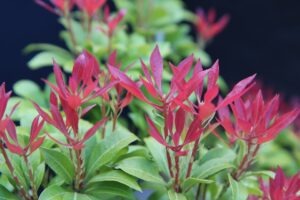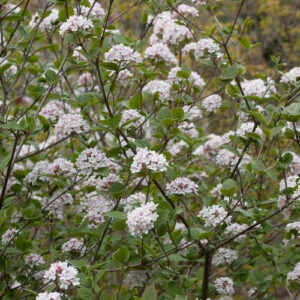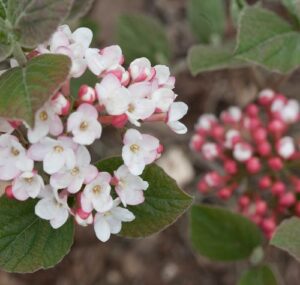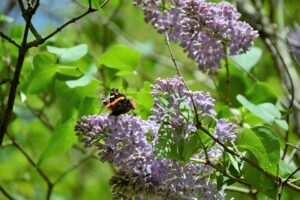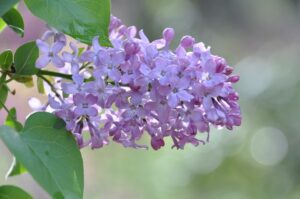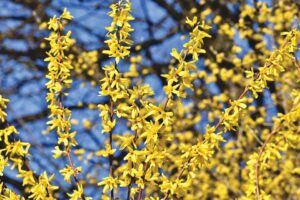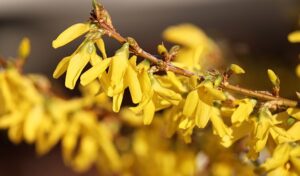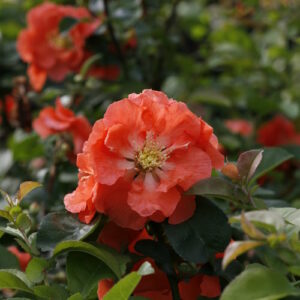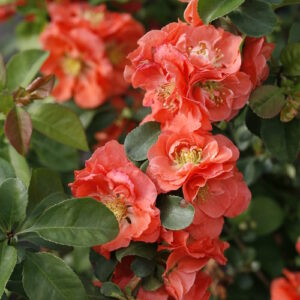March (Spring) is the PERFECT time to start a fresh garden project so to spark your landscape excitement we’re sharing our Top 5 Spring Blooming Shrubs.
Landscape professionals and homeowners love spring blooming shrubs for their color after a long winter and for their important role in balancing natural habitats. Opening buds are a welcome food source for beneficial pollinators like bees and hummingbirds while both evergreen and deciduous foliage creates shade and shelter for birds and insects. There are hundreds of spring blooming shrubs that thrive in the Pacific Northwest, but here are five of our favorites, selected for their bright new foliage, bursting blooms or scent.
We hope our suggestions get your imagination going and help with your spring landscape projects!
1. Pieris japonica ‘Mountain Fire’ (Mountain Fire Andromeda)
- Mountain Fire Andromeda Flowers
- Mountain Fire Andromeda Shrub
DETAILS AND CARE INSTRUCTIONS
Rate of Growth: Moderate, reaching approximately 4’ tall, 3’ wide .
Growing Habit: Spreading Mound
Seasonal Interest: Scented flowers bloom in Spring. Evergreen leaves support flower petals in shades of white with new growth showing red in spring.
Exposure and Climate: Part Sun- Shade, Zones 5-8
Water Needs: Always water until established. Do not allow soil to get overly moist. Refer to the nursery plant tag for specific care and/or when the top 2 inches of soil are dry. Needs an acidic soil to thrive.
Uses: Andromeda work well on their own or in a border along driveways, and cottage pathways. Works well as a companion to perennial flowers in an area of the garden with afternoon shade.
2. Viburnum carlesii (Korean Spice Viburnum)
- Korean Spice Viburnum Shrub
- Korean Spice Viburnum Flower Clusters
DETAILS AND CARE INSTRUCTIONS
Rate of Growth: Moderate, reaching approximately 6’ tall, 6’ wide canopy per variety.
Growing Habit: Upright
Seasonal Interest: Distinct white flower clusters have a beautiful warming scent.
Exposure and Climate: Full sun to part shade, Zones 4-8
Water Needs: Always water until established. Refer to the nursery plant tag for specific care and/or
when the top 2 inches of soil are dry.
Uses: Korean Spice Viburnum is a deciduous shrub that looks best as a border plant and along either side of a front entry. Plant adjacent to a window for a view of the flowers, berries and changing foliage in the fall.
3. Syringa vulgaris ‘Lavender Lady’ (Lavender Lady Lilac)
- Lavender Lady Lilac Shrub
- Lavender Lady Lilac Blooms
DETAILS AND CARE INSTRUCTIONS
Rate of Growth: Grows quickly, reaching approximately 12’ tall, 6’ wide canopy.
Growing Habit: Upright, multi-branching form
Seasonal Interest: Scented flowers bloom in late Spring. Flower petals are a lovely shade of light purple.
Pretty bark adds year-round interest.
Exposure and Climate: Full sun, Zones 5-8
Water Needs: Always water until established. Refer to the nursery plant tag for specific care and/or
when the top 2 inches of soil are dry.
Uses: Lavender Lady Lilac is a plant with timeless charm.
4. Forsythia x “Springshine‘’ (Springshine Forsythia)
- Springshine Forsythia Shrub
- Springshine Forsythia Detail
DETAILS AND CARE INSTRUCTIONS
Rate of Growth: Moderate, reaching approximately 2’ tall, 3’ wide.
Growing Habit: Round and Deciduous
Seasonal Interest: Tubular flowers bloom and attract hummingbirds. Flower petals are yellow.
Exposure and Climate: Full sun, Zones 4-8
Water Needs: Always water until established. Refer to the nursery plant tag for specific care and/or
when the top 3 inches of soil are dry.
Uses: Springshine Forsythia shrubs add vibrant color and energy to garden beds. Pairs beautifully with with Quince Shrubs and Redbud Trees.
5. Chaenomeles s. ‘Double Take Orange’ (Double Take Orange Quince)
- Double Take Orange Quince Flower
- Double Take Orange Quince Shrub
DETAILS AND CARE INSTRUCTIONS
Rate of Growth: Moderate, reaching approximately 3-4’ tall, 3-4’ wide.
Growing Habit: Upright and Deciduous and without Thorns.
Seasonal Interest: Flowers bloom in Spring. Flower petals are a peach orange color with ruffled edges.
Exposure and Climate: Full sun-Part Sun, Zones 5-9
Water Needs: Always water until established. Refer to the nursery plant tag for specific care and/or
when the top 2 inches of soil are dry.
Uses: Double Take Orange Quince is a beautiful vibrant variety. Surprisingly, this variety is missing those sharp pesky thorns! Great plant to use in garden beds and containers. Take a few cuttings to put in your favorite vase!
Keep enjoying “Top 5 Performing Plants for the Pacific Northwest” with Harmony Design Northwest by subscribing to our newsletter and be on the lookout for our next post.
Content contributor: EMILY PURDIN | stonybrooklandscapedesign.com
Credit to MONROVIA for plant sizes and care instructions. www.monrovia.com
Photo credit to PIXABAY and their wonderful contributors. www.pixabay.com
Photo credit to Proven Winners and their wonderful photographers. www.provenwinners.com



